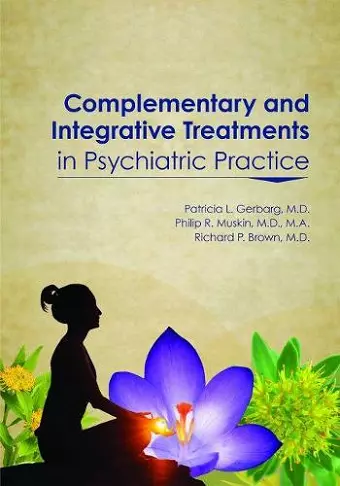Complementary and Integrative Treatments in Psychiatric Practice
Philip R Muskin editor Richard P Brown editor Patricia L Gerbarg editor
Format:Paperback
Publisher:American Psychiatric Association Publishing
Published:20th Aug '17
Currently unavailable, and unfortunately no date known when it will be back

With its unrivaled scope, easy readability, and outstanding clinical relevance, Complementary and Integrative Treatments in Psychiatric Practice is an indispensable resource for psychiatric and other health care professionals. It is also well suited for individuals with mental disorders and their family members who are seeking updated, practical information on complementary, alternative, and integrative medicine (CAIM).
An international group of experts, researchers, and clinicians examines an expansive range of treatments that have been chosen on the basis of their therapeutic potential, strength of evidence, safety, clinical experience, geographic and cultural diversity, and public interest.
This guide offers advice on how to best tailor treatments to individual patient needs; combine and integrate treatments for optimal patient outcomes; identify high-quality products; administer appropriate doses; and deal with concerns about liability, safety, and herb-drug interactions. Treatments discussed include:
• Nutrients and neutraceuticals
• Plant-based medicines
• Mind-body practices—breathing techniques, yoga, qigong, tai chi, and meditation
• Art therapy and equine therapy for children and adolescents
• Neurotherapy, neurostimulation, and other technologies
Psychiatrists and other physicians, residents, fellows, medical students, psychologists, nurses, and other clinicians will benefit from guidelines for decision making, prioritizing, and combining CAIM treatments, as well as safely integrating CAIM with standard approaches.
That the treatments considered in this clinician's guide are applied to five of the major DSM-5 categories—depressive disorders, anxiety disorders, trauma- and stressor-related disorders, bipolar and related disorders, and schizophrenia spectrum and other psychotic disorders—ensures its applicability, timeliness and timelessness.
Strengths: This book exposes the reader to a wide array of diverse treatment options that are not ordinarily taught during medical training but that are nonetheless often utilized in the general population. The editors and authors have an evidence-based focus, while often providing information on specific indications, contraindications, and mechanisms of action, as well as dosing tips. The index is particularly useful in helping readers sort through the book, and patient anecdotes help the reader envision practical applications for the information. Deficiencies: In an attempt to provide a comprehensive overview of complementary and integrative treatments in psychiatry, the book at times crosses the line between providing depth of information and being too dense making it difficult for readers to easily access and use the information. Rather than being read cover to cover, this book may be more suitable for use with the index to search for specific topics of interest as they pertain to patient care. Recommended Readership: This book would be a useful resource for psychiatrists or primary care providers, including residents and fellows.
-- Khushbu Shah, M.D., MPH and Mara Pheister, M.D. * Journal of Psychiatric Practice Vol. 24, No. 6 *I have sought quality resources on CAIM treatments in psychiatry (and specifically child and adolescent psychiatry) for 15 years and would recommend this book from Gerbarg, Muskin and Brown as a great introduction to the Western medicine-trained physician seeking guidance on evidence-based support for CAIM treatments. However, because of the paucity of evidence on many treatments included in CAIM, the authors fail to prioritize some foundational aspects of treatment and tend to emphasize lesser known and more infrequently used modalities.
-- Tiffany Sauls, M.D., Solstice East Residential Treatment Center, Weaverville, NC * Journal of the American Academy of Child and Adolescent Psychiatry *This is a well-referenced, reliable resource that reviews many of the available CAIM interventions. While a good percentage of our patients are already using CAIM, many of our patients do not respond to or tolerate traditional treatments. It therefore behooves us to be familiar with these interventions so we can responsibly guide and make recommendations to our patients.
-- Michael Easton, M.D. * Doody's Book ReviISBN: 9781615370313
Dimensions: 254mm x 178mm x 21mm
Weight: 739g
425 pages